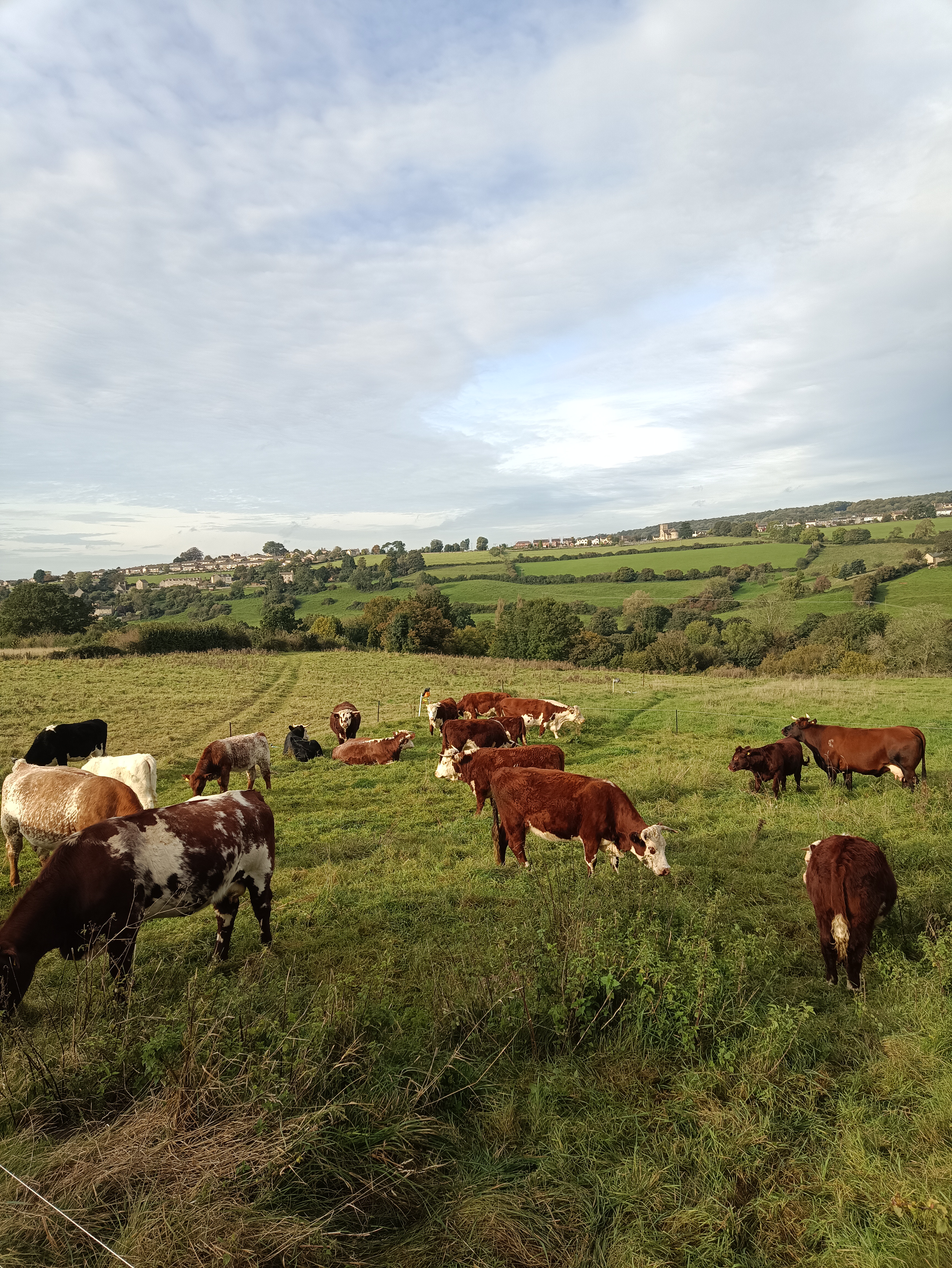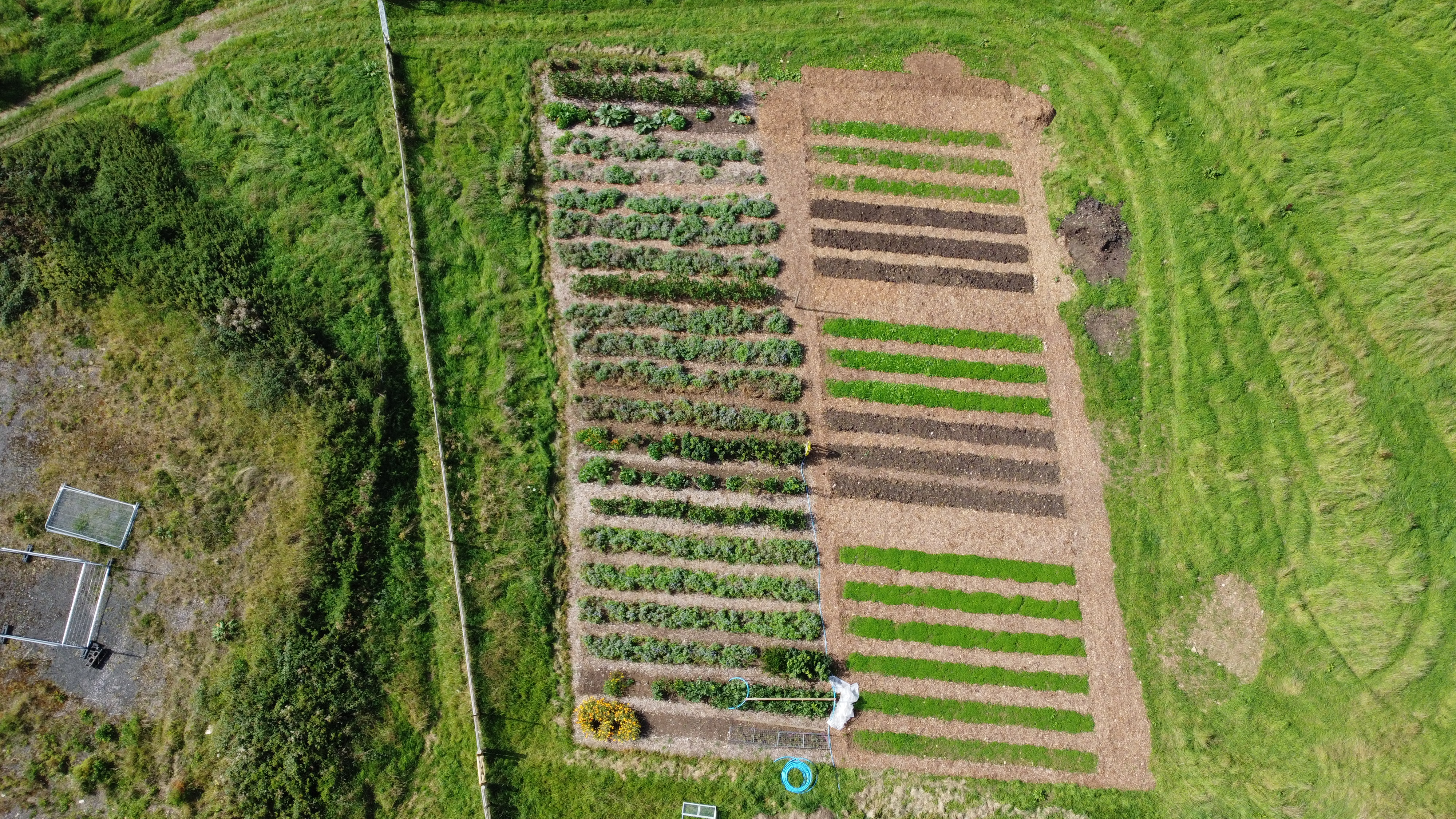Matt Dowen and Eric Walters, Good Small Farms, Gloucestershire 1/3
Tell us about your farm – location, size, altitude, climate, soils, enterprises, organic/Pasture for Life/other status etc.
We are a small, 100 acre farm on the outskirts of Stroud, which we are developing into a regenerative, ecologically sound farm that adds to the social capital and resilience of our local community. We operate a farming ecosystem that currently includes 5 enterprises (a market garden, renting out the farmhouse, agroforestry fruit and nut orchards, livestock and a tree nursery).
 (Photo: mob on the move)
(Photo: mob on the move)
We have roughly 70 acres of pasture with some of our fields planted up with tree crops, creating alleys in which we graze our cattle. We have a mixed herd of mainly Herefords, with some Beef Shorthorn - Parthenais crosses and some traditional Sussex too. We mob graze our herd, keep them out over winter and are slowly working towards a calving season starting in early June.
 (Photo: diverse mob in a diverse pasture)
(Photo: diverse mob in a diverse pasture)
We are operating on mainly Cotswold Brash soils; shallow and stoney with some heavier-clay areas. We are Pasture for Life certified and in Organic Conversion; on track to achieving full Organic Certification in May 2024.
Give us a picture of the biodiversity on your farm – essentially above ground (but reference to below ground if relevant) – both flora and fauna.
Nearly 200 different species of insects and mammals have been counted on our farm by our local ecologist, with hundreds more trees, plants and fungi. The mixed enterprise aspect of our farm has led to small niches for different wildlife species. For example, our tree nursery is built with no-dig beds and seems to be a wonderful place for voles to forage. This has led, as with many land use changes, to a swollen population of voles that has in turn attracted families of kestrels to take up residence. We have installed raptor posts and will be adding owl boxes this winter.
 (Photo: tree nursery using no-dig system: little weeding, plenty of voles!)
(Photo: tree nursery using no-dig system: little weeding, plenty of voles!)
The agroforestry fields attract both Roe and Muntjac deer; all our trees are ‘protected’ behind electric polywire fencing and we have had varying degrees of success keeping the deer out. A local deerstalker comes to help us out and supplies us with some delicious venison to pay us for his services!
Our larger pastures are home to Skylarks and their impressive displays in the summer months; once the cows have passed through the pasture there is plenty of cover left on the ground for them to nest in.
 (Photo: Tawny Owl captured with wildlife camera visiting Sheffieldwildlifecam)
(Photo: Tawny Owl captured with wildlife camera visiting Sheffieldwildlifecam)
We have been on the farm for two and a half years. The previous owners had alpacas on half the farm and the rest was cut for hay. Prior to that, the farm was run as a fairly intensive beef operation. Some fields have an increasing number of thistles which had been causing our stockman a growing amount of concern. However, ‘eradicating the thistles’ was dropped from the priority list when one sunny summer’s afternoon, a charm of finches flew in and gorged themselves on the thistle seeds. As long as they aren’t taking over our pastures we are for now choosing to leave them and all the ecosystem services that they provide in place.
One of our neighbours approached us in the summer and, jokingly, complained about how we were treating the land as all of the birds that used to be in his garden now prefer to be in the fields and hedgerows.
 (Photo: a moth (Stigmella Floslactella) mining on Hazel by Graeme Davis)
(Photo: a moth (Stigmella Floslactella) mining on Hazel by Graeme Davis)
As we have only been on the land a short time, we are yet to see dramatic changes in the soil and the below-ground life. However we are documenting our soils using Soilmentor to have an ongoing record. The tree nursery has started to see variations between the permanent alder rows (used as a windbreak and nitrogen fixer), the woodchip paths, and the tree beds. Longer roots have led to worm and microbe activity seen much deeper in the soil.
 (Photo: Pyramidal Orchid (Anacamptis pyramidalis) by Graeme Davis)
(Photo: Pyramidal Orchid (Anacamptis pyramidalis) by Graeme Davis)
What do you to encourage this biodiversity?
We are taking part in a Habitat Restoration scheme in conjunction with the National Trust whereby we will be reseeding a 9-acre field with a wildflower meadow mix. This is part of a wider project connecting habitats in the local area. In effect, this field will have a reduced grazing schedule as well as grazing periods timed so as to not inhibit the full expression of the wildflowers sown.
 (Photo: cattle grazing in between rows of tree crops)
(Photo: cattle grazing in between rows of tree crops)
Our grazing system encourages life both above and below the soil. In the growing season we mob graze just the tops of the sward and leave or trample what remains. We aim to keep the pastures in a vegetative state for as much of the growing season as possible and when we can’t, the older woodier material is very easily trampled to the ground to degrade with time. These aspects of our grazing system help to maintain a living soil and thus feed the rest of the ecosystem.
 (Photo: new stream before trees planted either side)
(Photo: new stream before trees planted either side)
In conjunction with Stroud District Council’s Natural Flood Management Officer, we have broken some field drains and established a pond. We have cordoned off some of a field in order to allow the area to develop as a wetland, following the natural slopes to ‘slow the flow’ of water off the land and into the Painswick Stream, in the hope of reducing the risk of flooding further downstream in Stroud.
A local apiarist keeps bees on the farm which help with the pollination of our orchards and certain crops in the market garden. With only a handful of hives we hope that plenty of space is left for the local, wild pollinators too.
 (Photo: grey wagtail at the newly established pond by Graeme Davis)
(Photo: grey wagtail at the newly established pond by Graeme Davis)




